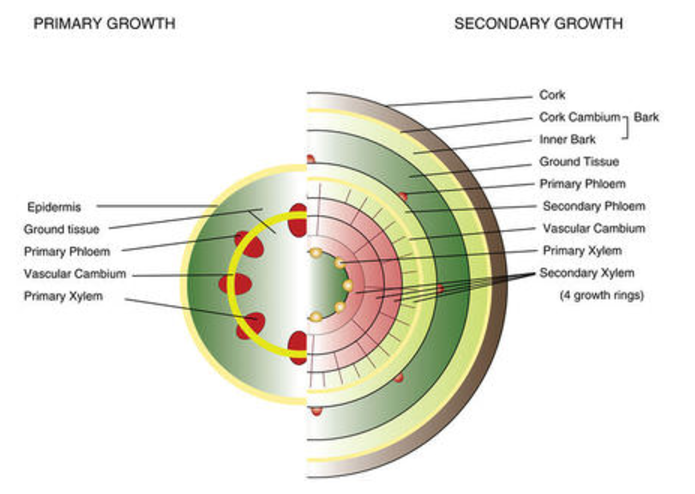Learning Outcomes
- Describe the way that plants grow

Figure 1. There must be an area of growth, similar to how the bones in your fingers, arms, and legs grow longer. There is, and it is called the apical meristem, which is shown here.
Most plants continue to grow throughout their lives. Like other multicellular organisms, plants grow through a combination of cell growth and cell division. Cell growth increases cell size, while cell division (mitosis) increases the number of cells. As plant cells grow, they also become specialized into different cell types through cellular differentiation. Once cells differentiate, they can no longer divide. How do plants grow or replace damaged cells after that?
The key to continued growth and repair of plant cells is meristem. Meristem is a type of plant tissue consisting of undifferentiated cells that can continue to divide and differentiate.
Apical meristems are found at the apex, or tip, of roots and buds, allowing roots and stems to grow in length and leaves and flowers to differentiate. Roots and stems grow in length because the meristem adds tissue “behind” it, constantly propelling itself further into the ground (for roots) or air (for stems). Often, the apical meristem of a single branch will become dominant, suppressing the growth of meristems on other branches and leading to the development of a single trunk. In grasses, meristems at the base of the leaf blades allow for regrowth after grazing by herbivores—or mowing by lawnmowers.
Apical meristems differentiate into the three basic types of meristem tissue which correspond to the three types of tissue: protoderm produces new epidermis, ground meristem produces ground tissue, and procambium produces new xylem and phloem. These three types of meristem are considered primary meristem because they allow growth in length or height, which is known as primary growth.

Figure 2. Microphotograph of the root tip of a broad bean show rapidly dividing apical meristem tissue just behind the root cap. Numerous cells in various stages of mitosis can be observed.
Secondary meristems allow growth in diameter (secondary growth) in woody plants. Herbaceous plants do not have secondary growth. The two types of secondary meristem are both named cambium, meaning “exchange” or “change.” Vascular cambium produces secondary xylem (toward the center of the stem or root) and phloem (toward the outside of the stem or root), adding growth to the diameter of the plant. This process produces wood, and builds the sturdy trunks of trees. Cork cambium lies between the epidermis and the phloem, and replaces the epidermis of roots and stems with bark, one layer of which is cork.

Figure 3. Primary and secondary growth
Woody plants grow in two ways. Primary growth adds length or height, mediated by apical meristem tissue at the tips of roots and shoots—which is difficult to show clearly in cross-sectional diagrams. Secondary growth adds to the diameter of a stem or root; vascular cambium adds xylem (inward) and phloem (outward), and cork cambium replaces epidermis with bark.
Watch this time-lapse video of plant growth. Note that there isn’t any narration in the video.
You can view the descriptive transcript for “Time lapse radish seeds sprouting, top and roots growing” here (opens in new window).
In Summary: How Plants Grow
Most plants continue to grow as long as they live. They grow through a combination of cell growth and cell division (mitosis). The key to plant growth is meristem, a type of plant tissue consisting of undifferentiated cells that can continue to divide and differentiate. Meristem allows plant stems and roots to grow longer (primary growth) and wider (secondary growth).
Try It
